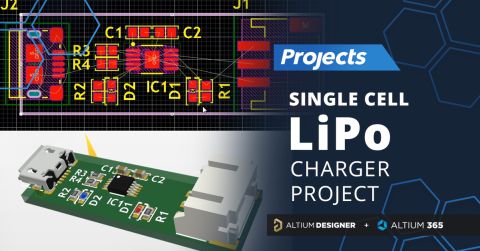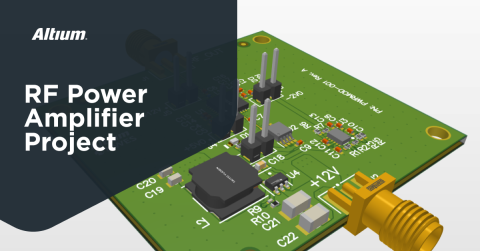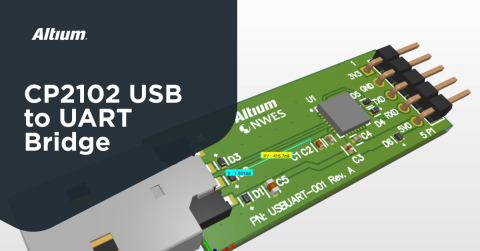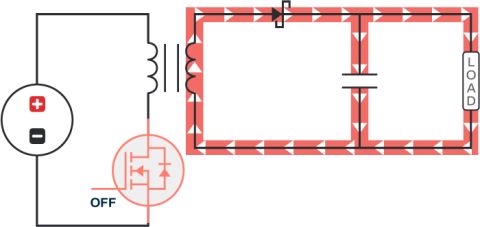
Low Noise, Low EMI Power Distribution

Previously I built a 5V, 5A regulator for my entry-level cinematography camera, the Blackmagic Ursa Mini Pro G2 4.6K. It features isolated 5V power supplies for the radio microphones and extensive power filtering to ensure the highest quality power throughout the system. My shoulder rig for the camera has several fixed loads, which I don’t want to have to unplug individually when I take the camera off the shoulder rig. Therefore, I’m making a board that can be mounted on the shoulder pad’s front rails that will provide power distribution and further filtering.
In the previous article, I wasn’t sure if I was going to write about this board and section of the project or put it up on GitHub. However, I had some requests for a followup on the front distribution board. As always, you can find this project on GitHub under the MIT license, so you can make your own or take portions of the schematic for your own projects. You’ll find all the components for the board in my open source Celestial Altium Library. You can also find the main power supply board, which this board will plug into on GitHub as well.
This board has several loads on it, but it is purely a distribution board with no regulation. The main loads are the hefty 5V Tilta nano focus motor, 5V SDI to HDMI converter, 5V Tilta follows focus control, and the battery voltage powered monitor. Out of these, only the SDI to HDMI convert needs remotely clean power. The motor, however, is very electrically noisy, so it needs good isolation.
I plan to have a couple of extra power outputs available for future usage, perhaps for powering a light, a recorder, or another device that I haven’t yet added to my setup. While the power from the camera is filtered on the main unit, I also want to have filtering on the front distribution board. The main regulator’s filter is to protect the camera from electrical noise being conducted back to it and potentially interfere with the audio or even video recording. The filtering on the front power distribution panel we are building in this article is to protect each plugged-in device from the possibility of receiving or transmitting conducted noise.
In addition to the power filtering, I’m also adding some basic ESD protection to each input. If you are kneeling on a carpeted floor, like many trade show venues have, building up a static charge as you are getting the camera ready plugging in devices presents a very easy way for an ESD event to damage a fairly expensive piece of equipment. By having ESD protection on the inputs as well as on the regulator board, we should have a fairly high degree of protection for the camera. I’m using the same 0402 size TVS diodes for the 5v lines that I used on the main power board—the TI TPD1E10B06QDPYRQ1. These are tiny but automotive qualified and likely to be capable of handling ESD events at sea level in mid to high humidity conditions. The double ESD protection will handle the ESD event in a high altitude, low humidity setting such as Denver, CO, or Calgary, AB present.

The Schematic
As you might expect from a power distribution board, the schematics are fairly simple, but still contain more components than just the connectors. As mentioned earlier, this project has a lot of filtering. Power quality is essential to me in this project, so there’s no such thing as too much filtering!

The 5V input’s large capacitance combined with the cable also provides an interesting RC filter between this distribution board and the regulator. I measured the resistance of the 300mm cable with connectors, as 0.015 ohms. This resistance, combined with the 1640uF of capacitance, we get a cutoff frequency of 6.47 kHz, which will block any frequencies we are likely to encounter. As the 5V supply will have a motor that can draw over 2A on it and has rapid transient current draws from the motor, I need a lot of capacitance. This capacitance allows a more even current draw from the regulator even under rapidly changing load conditions, which provides a more stable voltage for the other 5V devices.
The VCC_CLEAN net is just the battery voltage that was filtered on the regulator board. With only the monitor running off the battery voltage that has its own internal voltage regulators, there is little need for bulk capacitance. The expected load on the battery supply is a very consistent draw with few if any transients.

For the battery voltage output, I’m using two-barrel jacks. I’m not a fan of barrel jacks as they are too easy to unplug and come in so many different “almost the same” sizes, which can be plugged in but not necessarily have great contact. That being said, they are unfortunately widely available for cinematography applications, making them very user friendly versus crimping a less popular yet more reliable connector.
I tend to like using Pi filters; they are very efficient and have low DC loss compared to other filter topologies. This board is no exception—I have pi filters everywhere! The battery side filters are of modest capability and relatively compact in terms of board space.
With two identical filters and outputs, this could have been a perfect opportunity for a multi-channel design. Unfortunately, the board for this project is an odd shape, with very little real estate given the number of large components in the design. Therefore, the layouts are going to be different and not be able to take advantage of the multi-channel PCB layout tools. As this project is fairly simple, I’m keeping the design to a single schematic sheet, which means copying and pasting the first filter and connector is less effort than adding another schematic sheet.

The front USB connector, which powers the Tilta Nano hand controller, doesn’t need any filtering beyond a TVS diode for ESD protection. The device has an incredibly low current draw and also its internal regulator.

The PCB
Jumping ahead a bit, designing this PCB is exactly where I wish I had SolidWorks, Inventor, or Creo so I could use Altium’s MCAD-ECAD integration tools. It would have saved me a lot of time and hassle if I had these tools. I’m using Fusion360, which is decent software, but it’s just not on the same level as the other packages. I made a mistake when designing the board shape; the 3D model for the rail clamp that this board is going to fit to, a SmallRig 942/2061, was modelled for something to attach to the “top” of the block. When I modelled it, I did not include the fillet between the “bottom” face and the rail clamps of the block (shown on top below). As the only rail block I had was covered with other items, I couldn’t easily inspect it when I was designing the board shape. This first led me to design a board that was too wide, and then to import the incorrect board shape into Altium as a 3D model to use. It wasn’t until after I had completed the board layout that I received my shipment with the new rail block and realized my 3d model was wrong. If I had the MCAD integration tools, it would have been trivial to modify the board shape to suit the updated rail block model, instead, it took far longer than necessary!
Because of this mistake, we’ll skip right to the final board design. There’s not much interest in the actual board layout, but there are a few things I think you’ll find interesting about the board itself.

Firstly, you’ll notice that I have through-hole connectors on both sides of the board… which I would normally frown upon for a production board. The tight layout of the board means you could use a selective solder for the barrel jacks and USB connectors, but there’s no hope for the Molex 0430450600 under the board. This connector will almost certainly have to be manually soldered at any production volume.
Unfortunately, with the need to keep this board low profile, it has to sit between the two rails that the rail block mounts to. I need to have the Molex connector exit the right side of the board and go back to the power regulation module without wrapping wires all over the place—so it must be placed on the bottom of the board or the rail will be in the way.
Milling Profiles
One feature of Altium that really makes creating a panel with odd-shaped boards easy is the ability to create primitives (such as lines and arcs) from the board shape. By going to Design → Board Shape → Create Primitives From Board Shape, we can create a milling path the entire way around the board.
We do this by selecting the Route Tool Outline box and using the Route Tool Path layer, then set the width to something your PCB fabricator will not complain about milling. If you have cutouts in your board (like we did in the regulator board), you’ll want to Include Cutouts.

You might be thinking, “but then my board will just fall out of the panel.” There are two options we can take next to ensure a good quality panel:
- Create tabs or tabs with mouse nibbles to hold the board in the panel
- Use V-Cuts down two sides of the board
I generally prefer to use V-Cuts where possible, as they tend to be a little less effort for me to design an enclosure around.
By deleting the straight sections on either side of the board on the route tool path layer, I have given myself somewhere to place V-Cuts.

You might also notice I have weird cuts into the board on the internal corners. I’m not sure what size end mill my pcb fabricator will use, so I plan for a worst-case scenario—a 3mm end mill and design in dog bones. These cutouts allow me to fit a square object—such as my rail block—very tightly into the board. If I had the internal corner radius caused by an end mill, I might not get my board into position, which could cause it to flex when tightened down, which in turn could cause serious reliability and lifespan issues.
Now back to the panellization of the board. On my panel, each item now has a line drawn on the V Cutline. This is perfectly applicable to multiple rows as it is to my single row.



Clean Power for a Cinematography Camera Complete
With the two PCBs now completed and ordered, I have to confirm the mechanical design of my enclosures. I’ll be 3d printing the first enclosures, likely with my resin printer to ensure tight tolerances—then having a friend CNC mill a final enclosure from aluminium. After writing the previous article about the regulator, I changed the design to a much lower profile barrel jack for the input. This means I have to re-export my board and reassociate all the sketches I did against the components of the board that I imported. Once again, the MCAD integration tools would have saved me hours of work for a simple component change.
As mentioned before, you can find this open source project on GitHub, released under the permissive MIT license, so you can make use of any component of it in your own projects without worrying about the intellectual property rights!
Would you like to find out more about how Altium can help you with your next PCB design? Talk to an expert at Altium










